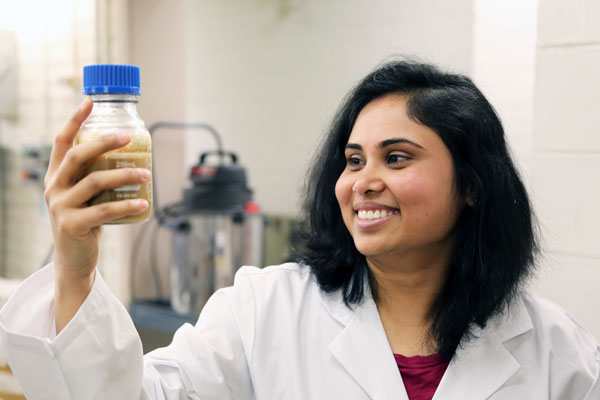 March 2, 2017 – Oil and water don’t mix — in theory. In reality, the two liquids can be almost impossible to separate, especially from complex chemical cocktails such as the wastewater produced by Alberta’s oil sands mining operations.
March 2, 2017 – Oil and water don’t mix — in theory. In reality, the two liquids can be almost impossible to separate, especially from complex chemical cocktails such as the wastewater produced by Alberta’s oil sands mining operations.
Contaminated by small amounts of bitumen and other oily substances, this wastewater can’t be discharged to the environment and is held in vast ponds awaiting treatment. A new potential solution developed by U of T Engineering researchers starts with a surprisingly simple device: a sponge.
Pavani Cherukupally (MIE PhD candidate) leads the project under the supervision of Professors Chul Park and Amy Bilton (both MIE). Previous work in Park’s lab focused on designing sponges that could be deployed to soak up oil in the event of a spill — these were made of superhydrophobic materials, which repel water but attract neutrally charged substances like oil.
Cherukupally is modifying the process to treat oil-sands wastewater. Her idea is to pump the the contaminated water through the sponges: due to attractive forces, the oily contaminants should stick to the surface of the sponge, while the clean water should flow straight through.
But when Cherukupally tried this with the superhydrophobic sponges, it didn’t work at all. “The water stayed just as dirty as it was,” she says.
Drawing on her background in physical chemistry, Cherukupally realized that the problem was that oil in wastewater behaves very differently than an oil spill. Oil in wastewater is dispersed into tiny droplets, rather than forming a cohesive slick. Each of these droplets is surrounded by a layer of charged particles, which means that they will be attracted to charged surfaces, not neutral ones.
Cherukupally ditched her neutral, superhydrophobic foams for ordinary polyurethane foam, similar to the type found in couch cushions. When she did, her sponge system removed more than 99 per cent of the suspended oil.